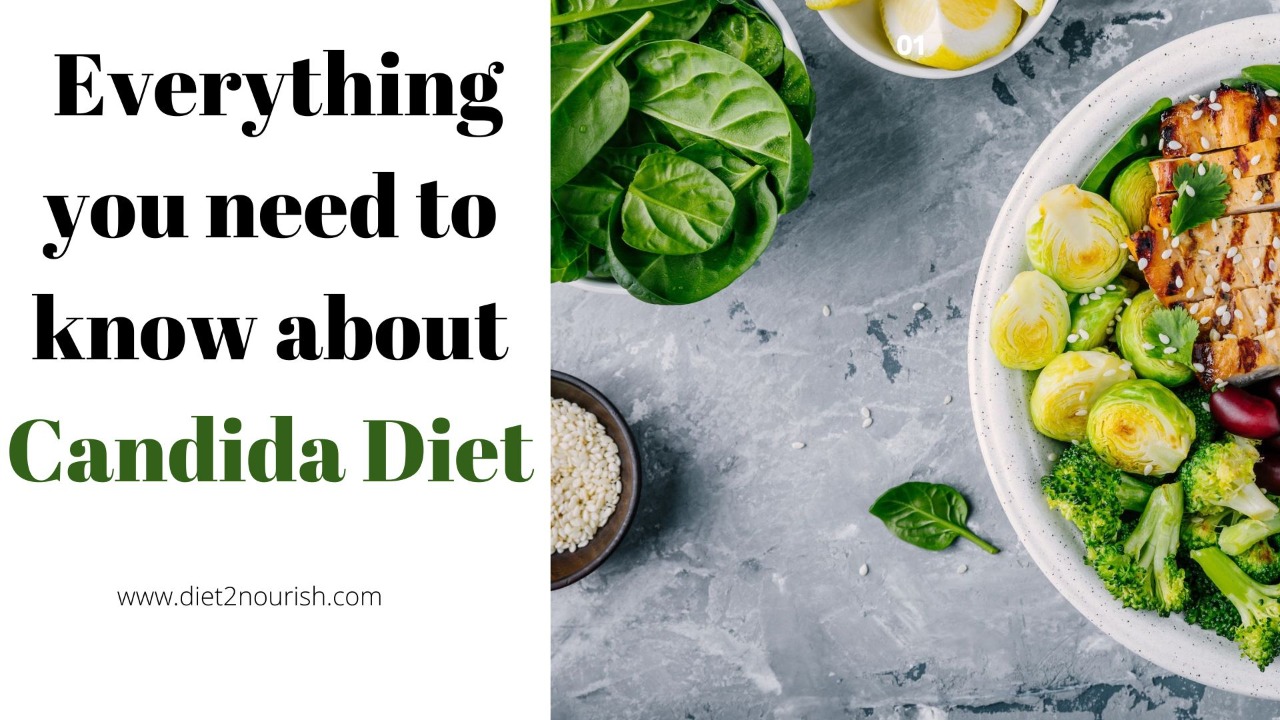Diet chart for Candida
Diet chart for candida is much required because candida yeasts produce alcohol and acetaldehyde as their main products as a result of metabolism. With levels of alcohol entering your bloodstream greatly increased and the body constantly absorbs higher levels of alcohol, your health is affected as the nutrients and valuable liver enzymes start depleting resulting in oxidative stress. Your whole body is poisoned by candida overgrowth resulting in damage to multiple body systems.‘Candida’ – the word might sound candid, but you may be astonished to know that the human body is home to candida, a bacteria found naturally in our gut.
Candida, meaning ‘clear and white’, is a collection of more than 20 species of yeasts that can result in many common bacterial infections. The human gut is home to over 1200 species of bacteria, yeasts, and other organisms, totaling tp over 100 trillion, that inhabit our gastrointestinal tract. These organisms are not bad and help us stay protected from diseases, and contribute towards our good health.
Amongst these trillions of microorganisms residing in the human gut, there are some of these friendly bacteria, which stay friendly when their numbers are kept controlled and low by the competing friendly bacteria. Candida is one of them. Kept under control they are good for us, but if they grow out of proportion, they change into a fungal form which may result in illnesses, different ailments, and issues with your weight. If you are suffering from candida, Candida Diet makes all the difference in the success and failure of eliminating the yeast from your system.
The Candida Diet
The candida diet is a type of diet that guides us and tells us what to eat and what food and drinks to avoid that could stop the risks of candida overgrowth. The whole aim of the diet is to minimize inflammation and balance the bacterial concentration inside our gut. The diet is focused on eating healthy fats, lean sources of proteins, non-starchy vegetables, and probiotics. The diet eliminates all foods that contribute to the growth of yeast.
In a nutshell, we can sum up that the candida diet is low in carbohydrates, and sugar, and generally low in fermented foods such as vinegar, alcoholic beverages, and alike. Though this diet may seem to be restrictive, it is high in nutrients.
Antifungal foods

In reality, some foods help rid our bodies of pathogenic yeasts and fungi. They have powerful nutrients that are anti-fungal and should be a must inclusion in any anti-fungal diet plan:
1. Garlic:
Garlic has very powerful anti-fungal properties that are not only good for the health of our gut microbiome but also attack candida.
2. Ginger:
Ginger is anti-inflammatory and is good for the removal of toxins from the body. It also helps stimulate the immune system and fight pathogens.
3. Onions:
Onions have very strong antifungal, antibacterial, and antiparasitic properties. It helps flush out the extra fluids from the body – the most common problem of water retention by candida sufferers.
4. Coconut Oil:
Coconut oil is considered one of the best against candida and the most potent antifungal. It helps prevent candida overgrowth and strengthens the immune system.
5. Olive Oil:
Olive oil is not just the best for cooking, but also contains powerful chemical and antifungal properties that help stimulate our immune system to fight candida.
6. Cinnamon:
This aromatic spice is a potent antifungal food. It helps in stabilizing the blood sugar and as candida wreaks havoc on the sufferer’s blood sugar, cinnamon is a perfect addition to any candida diet.
7. Turmeric:
Turmeric is anti-inflammatory and also harbors mild anti0fungal properties.
Foods that cause yeast infections
The candida diet includes a lot of foods to avoid yeast infection, mainly added sugars, glutenous grains, processed foods, fruits high in sugar, mostly all condiments, alcoholic beverages, some dairy products, and refined oils. The food list mentioned below are also the foods to avoid fungal infection:
1. Simple Carbohydrates:
Sugar, refined grains, glucose, and fructose may propagate yeast infection. This is mainly because of the lack of nutrients and also limits your intake of vitamins and minerals, the immune system needs desperately to fight candida.
2. Foods with yeast:
Foods that are made or manufactured with yeast or contain yeasts may also promote yeast infections. Things like alcohol, peanuts, and most cheeses should be avoided to control any infections from yeasts. Some other foods with yeasts are vinegar, pizza dough, bread, pastries, and alike.
3. Saturated Fats:
Saturated fats found in organ meats, processed meats, butter, cheese, full-fat dairy and dairy products, and almost all meats increase inflammation in our body.
4. Allergens:
Certain foods may be sensitive to us that when consumed may worsen yeast infections like wheat, shellfish, tree nuts, tomatoes, dairy, fish, soy, and peanuts. These foods when consumed show up symptoms like indigestion, itching, cramps, nausea, swelling in the face, and more.
Esophageal candidiasis diet
Candidiasis is a type of infection caused by a type of fungus called Candida. The fungus lives in our skin and inside our bodies in certain places like our mouth, vagina, gut, and throat. When the fungus multiplies, it causes infection in the area.
Candidiasis in a tube that connects the throat to the stomach is called esophageal candidiasis. It is also one of the most common kinds of infection in those who have been living with HIV/AIDS. The infection shows up as white patches in your inner cheeks, the roof of the mouth, and throat, soreness with redness, loss of taste, pain while swallowing and eating, cotton-like feeling in your mouth, and redness and cracking in the corners of your mouth.
A typical Esophageal candidiasis diet is a very restrictive one. The diet eliminates certain foods, and these are:
1. Fruits and Vegetables:
All frozen, canned, and dried fruits. As of vegetables are concerned, stick with non-starchy veggies like broccoli, tomatoes, and kale. Vegetables that are exposed to mold like mushrooms should be avoided.
2. Grains:
It is highly advised to avoid eating wheat and gluten. Foods made with yeast are also not allowed.
3. Proteins:
Red, organ and processed meats are a strict no. Shellfish and large fishes like swordfish and tuna are also excluded from the diet. However, lean protein sources like eggs, skinless poultry, and fatty fish are allowed. You may also include low mold nuts and seeds in your food list.
4. Dairy:
Full-fat dairy and dairy products should be limited; however, you can have probiotic yogurt, real butter, and ghee. Moldy cheeses, frozen dairy products, cream cheese, processed cheeses, ice cream, and sugary milk and yogurt should be avoided.
5. Beverages:
An Alcoholic beverages should strictly be avoided. A Sugary drinks, fruit juices, milkshakes, milk-based coffee drinks, and all other sweetened beverages should also be avoided. However, it is recommended to have herbal teas. Normal coffee and tea can be taken in moderation.
Please Note: The above-mentioned foods are also included or excluded as described in any diet for fungal infection.
Frequently Ask Questions:
The list of foods that you can eat while on the candida diet:
Non-starchy vegetables: Cabbage, Brussel sprouts, kale, broccoli, asparagus, zucchini, eggplant, cucumber, onion, tomatoes, and celery.
Fruits low in sugar: Lime, lemon, and berries (in smaller quantities).
Non-glutenous grains: millet, oat bran, buckwheat, and quinoa.
Healthy proteins: Chicken, eggs, salmon, sardines, and turkey.
Certain dairy products: Butter, ghee, and plain yogurt.
Fermented foods: Kefir and sauerkraut.
Nuts and seeds: Sunflower seeds, almonds, and flax seeds.
Herbs: Oregano, rosemary, paprika, thyme, and dill.
Spices: Turmeric, black pepper, garlic, ginger, salt, and cinnamon.
Healthy Fats: Olives, and avocado.
Oils: Extra virgin olive oil, unrefined coconut oil, sesame oil, and flax oil.
The list of foods to be avoided if you have candida are:
Fruits with high sugar: Banana, mango, grapes, raisins, and dates.
Glutenous grains: wheat, rye, and barley.
Meats: Deli meats.
Oils and Fats: Soyabean oil, canola oil, sunflower oil, and margarine.
Dairy products: Cream, cheeses, and milk.
Nuts and Seeds: Peanuts, cashew nuts, pistachios, and pecans.
Condiments: White vinegar, soy sauce, mayonnaise, BBQ sauce, and ketchup.
Sugar: Cane sugar, honey, maple syrup, table sugar, and artificial sweeteners.
Food additives like nitrates and sulfates.
Beverages: All alcoholic beverages (wines, beers, spirits, etc.), caffeinated teas, coffee, soda, energy drinks, and fruit juices.







